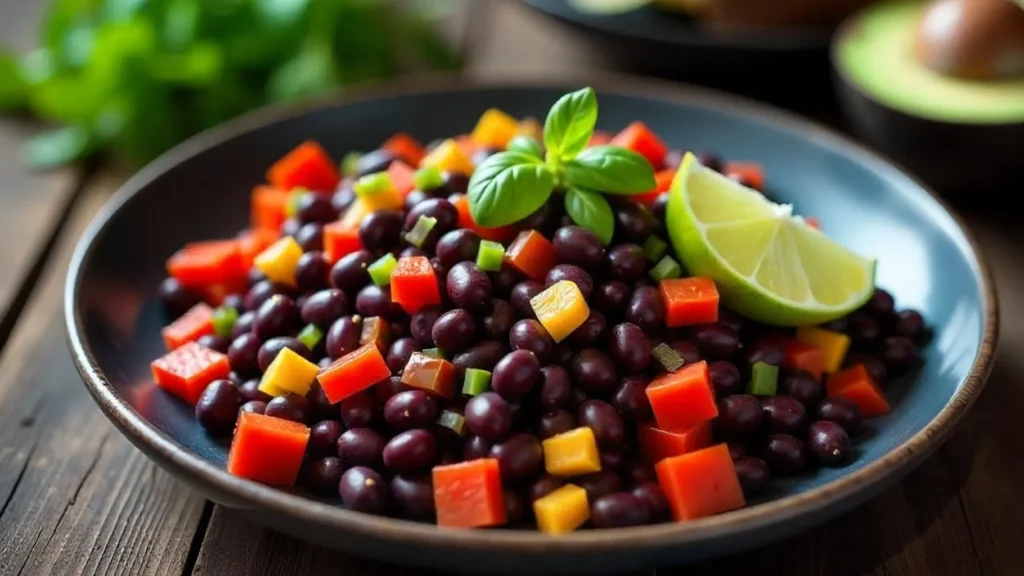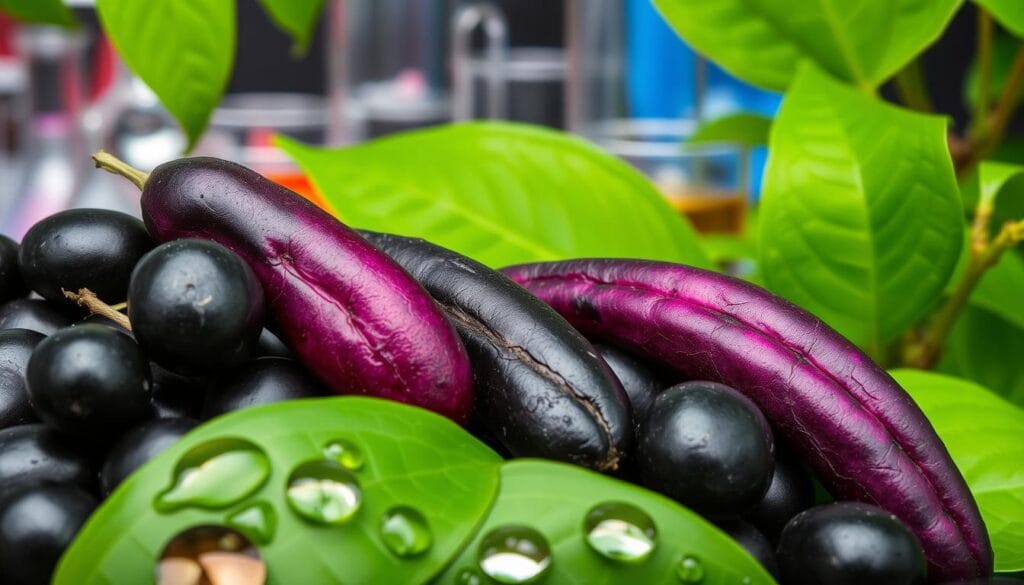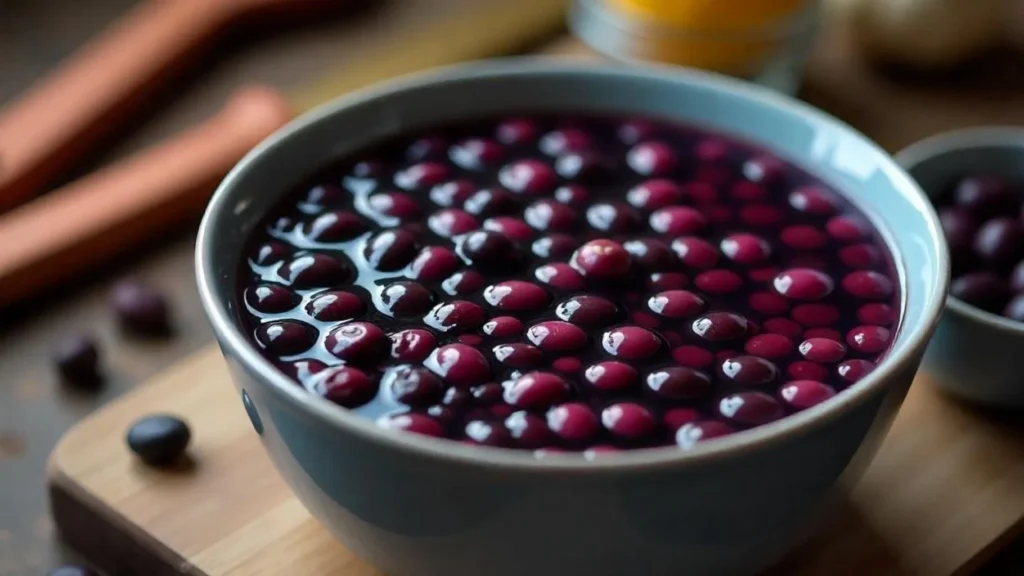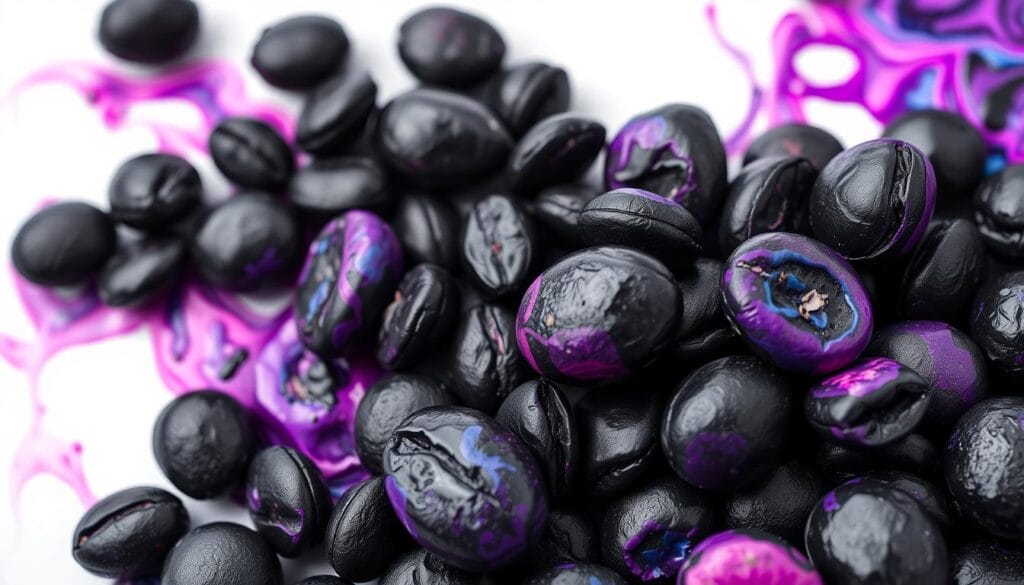
Ever pulled a pot of black beans off the stove and wondered, “Why do black beans turn purple?” The deep, rich black color transforming into a mysterious purple hue is not a kitchen mishap but a fascinating story of culinary science.
Black beans are more than just a simple ingredient. Their deep color tells a complex chemical story that unfolds during cooking. The transformation from black to purple shows the hidden world of natural pigments in these nutritious legumes. Understanding this color change helps us appreciate the chemistry happening in our kitchens.
When you cook black beans, their outer layer contains special water-soluble pigments called anthocyanins. These natural compounds cause the dramatic color shift you might see. Temperature, water pH, and cooking methods all affect this amazing color transformation of black beans.
Table of contents
Understanding the Science Behind Why Black Beans Turn Purple
Black beans have a secret that goes beyond their color. They show a complex chemical dance that changes them in surprising ways.

The magic of color change in beans comes from special molecules called anthocyanins. These natural pigments make vibrant colors in many foods, including black beans.
The Role of Natural Pigments
Anthocyanins are powerful compounds that change color with environmental changes. Their unique structure lets them shift colors based on:
- pH levels in cooking water
- Temperature during preparation
- Cellular structure of the bean
Chemical Structure of Anthocyanins
These pigments can change color dramatically. When beans are heated, their cell walls break down. This releases anthocyanins, changing the bean’s color from black to purple.
How Heat Affects Bean Pigmentation
Cooking methods greatly affect bean color changes. Different temperatures and cooking techniques can cause small changes in pigmentation. Understanding these mechanisms helps you appreciate the complex chemistry happening in your kitchen.
The color of a bean is more than just a visual trait—it’s a window into its chemical composition.
In 2022, global pulse production hit 93 million metric tons. Common bean production was about 31.8 million tons. This shows how important it is to understand the science behind these amazing legumes.
Why Do Black Beans Turn Purple? The Science Explained
Ever wondered why black beans turn purple when you cook them? The answer lies in fascinating bean chemistry. Special pigments called anthocyanins are responsible for this striking black bean color change in your kitchen. These natural compounds react to heat, water pH, and cooking methods, creating the vibrant purple hue. Understanding why black beans sometimes turn purple adds a new appreciation for the science of cooking.

Black bean color change is a natural process. It’s influenced by a few key factors:
- Water pH levels impact pigment appearance
- Cooking temperature affects anthocyanin release
- Bean variety determines color intensity
When you cook black beans, heat breaks down cell walls. This lets water-soluble anthocyanins mix into the cooking water. These purple pigments change color based on the environment:
- Acidic water produces reddish tones
- Alkaline water creates bluish-purple colors
- Neutral pH results in subtle color shifts
“Nature’s chemistry is most visible in the subtle color transformations of our favorite ingredients.” – Culinary Science Expert
The color change doesn’t affect the bean’s nutritional value or safety. In fact, the anthocyanins behind this purple spectacle are good for you. They help fight inflammation and support heart health.
The Fascinating Chemistry Behind Why Black Beans Turn Purple
The world of bean pigment chemistry is complex and fascinating. It’s not just about why black beans turn purple during cooking. This transformation involves the intricate interactions of natural compounds like anthocyanins with their environment, showcasing the science behind this black bean color change.

Bean pigment chemistry shows how science affects the look of legumes. The color changes are not random. They come from specific chemical reactions with anthocyanins.
Water pH and Color Changes
The pH of water is key in changing bean colors. Acidic water keeps colors dark, while alkaline water brings out purple. Here are some key points:
- Acidic water (low pH) preserves deep black bean colors
- Alkaline water (high pH) promotes purple pigment expression
- Neutral pH can create intermediate color variations
Temperature Effects on Anthocyanins
Temperature affects anthocyanin stability. Higher temperatures speed up pigment breakdown, leading to quick color changes. Controlling temperature during cooking helps keep bean colors bright.
Environmental Factors in Bean Coloration
Many environmental factors affect bean color. Soil composition, growing conditions, and storage methods all play a role in the pigments in black beans.
“Nature’s color palette is a delicate dance of chemical interactions” – Agricultural Color Research Institute
Understanding these chemical processes helps us appreciate the science behind bean color changes. It also helps us keep the natural pigments during cooking.
Health Benefits Related to Why Black Beans Turn Purple
Black beans are full of nutrients and offer amazing health benefits. Ever wondered why black beans turn purple during cooking? The purple pigments, called anthocyanins, are responsible for this color change and also protect your body in many ways. These compounds, behind the black bean color change, are strong antioxidants that help keep you healthy.
The benefits of black bean pigments go beyond their color. Studies show that eating anthocyanins can help in several ways:
- Protects cells from damage
- Reduces inflammation
- Improves heart health
- Helps control blood sugar
Research into black bean nutrition is very interesting. Scientists found that Tolosa black beans from different places have lots of antioxidants. These beans can help prevent heart disease, manage weight, and control diabetes.
“Over 600 unique anthocyanins exist in nature, with cyanidin representing 33% of identified compounds across 434 plant species.”
Eating black beans can greatly improve your diet. Their antioxidants help protect cells and improve metabolism. Cooking them can make these nutrients even more available, making black beans a great choice for your health.
- Cyanidin-rich pigments provide robust health support
- Cooking increases polyphenol absorption
- Natural antioxidants combat cellular damage
Learning about black bean pigments helps you make better food choices. This can lead to better health and well-being in the long run.
Common Cooking Methods and Why Black Beans Turn Purple
Cooking black beans is more than just making a tasty dish. Ever wondered why black beans turn purple during cooking? Your cooking methods play a significant role in this black bean color change, influencing both their appearance and nutritional value. Understanding how different techniques affect their color helps you keep them dark, rich, and visually appealing.
Traditional Cooking Techniques
Old-fashioned slow-cooking methods have special effects on bean color. These methods include:
- Soaking beans overnight
- Simmering at low temperatures
- Using cast-iron or clay cookware
Modern Kitchen Approaches
New cooking methods keep black beans looking great. Pressure cookers and instant pots make cooking faster and better by:
- Shortening cooking time
- Keeping color from changing
- Keeping nutrients in
Temperature Control Methods
Controlling temperature is key to keeping beans dark. Professional chefs suggest several ways to keep beans looking dark:
Managing heat and water pH greatly affects your black beans’ look.
Using these cooking techniques ensures your black beans look good and taste great. They also keep their nutritional value.
Preserving Black Bean Color During Cooking: Why Do Black Beans Turn Purple?
Cooking black beans can be tricky to keep them from turning purple. Success in the kitchen depends on a few key techniques. These methods help keep your beans dark and delicious.
- Use soft or filtered water to minimize mineral interactions
- Add a splash of acidic ingredients like lemon juice or vinegar
- Control cooking temperature carefully
- Reduce overall cooking time
Water quality is key for bean color. Soft water helps maintain the beans’ natural color by reducing chemical reactions that cause unwanted color changes.
“The secret to beautiful black beans is understanding their delicate chemistry” – Culinary Experts
Here are specific strategies for color retention:
| Technique | Color Preservation Impact |
|---|---|
| Quick-soaking method | Minimizes pigment release |
| Filtered water usage | Reduces mineral-induced color changes |
| Acidic ingredient addition | Stabilizes anthocyanin pigments |
Remember, some color variation is natural. Your goal is to minimize dramatic changes while maintaining the beans’ delicious flavor and nutritional value.
Natural Color Variations and Why Black Beans Turn Purple
Black bean varieties show a wide range of colors that amaze both food lovers and scientists. To grasp these color changes, we must explore the world of pigmentation and how the environment affects it.
Looking into black bean varieties, we find interesting color changes. These changes are influenced by genetics and other factors.
Regional Bean Types and Their Unique Characteristics
Each region has its own black bean types with unique colors. Research has uncovered some interesting facts:
- Over 50 bean varieties were documented during a single growing season
- Some varieties showed multiple color layers
- Specific color combinations included Red Purple White and Lavender
Seasonal Impact on Bean Colors
The season greatly affects bean colors. Sunlight, soil, and temperature can cause color changes in black beans.
| Season | Color Variation Impact |
|---|---|
| Spring | Lighter pigmentation, possible purple hints |
| Summer | Intense dark coloration |
| Fall | Gradual color fading |
Storage Effects on Bean Pigmentation
Storing beans properly is key to keeping their color. Cold storage helps keep the unique colors of certain beans, like their light background.
“The beauty of bean varieties lies in their remarkable ability to transform and adapt to different environmental conditions.” – Agricultural Research Collective
Understanding these natural color changes helps us appreciate the complex world of black bean pigmentation. Each bean has its own story of genetics and environment.
Cultural Significance of Black Beans: Why Do They Turn Purple?
Black beans are key in many global cuisines. They are more than food; they carry cultural and historical values. This is true across various regions.
In Latin America, black beans are essential. They are the heart of dishes like Cuban black beans and rice, Brazilian feijoada, and Mexican bean stews.
“Black beans are not just food, they are a cultural narrative passed through generations” – Chef Maria Rodriguez
- Regional Culinary Significance:
- Caribbean: Primary protein source in many traditional dishes
- Southern United States: Staple in soul food and Creole cooking
- Brazil: Essential ingredient in national dish feijoada
Black beans are used in many ways around the world. Each culture has its own way of cooking them. This shows how adaptable and important they are.
| Region | Cultural Bean Dishes | Preparation Style |
|---|---|---|
| Latin America | Feijoada | Slow-cooked stew |
| Caribbean | Rice and Beans | Simmered with spices |
| Southern US | Black Bean Soup | Hearty, seasoned broth |
Interestingly, Latinx individuals consume more beans compared to any other racial or ethnic group in the US. This shows their deep connection to these versatile legumes.
Conclusion
Exploring bean color science opens up a world of culinary wonder. Black beans are not just simple ingredients. They show how natural pigments and cooking methods come together. The purple color that appears when cooking is a sign of their nutritional richness.
Learning about black bean cooking methods helps you improve taste and nutrition. You can choose between dried and canned beans. Adding spices like smoked paprika and chipotle powder can also make a big difference. Each way of cooking lets you see the beans’ amazing color-changing abilities.
No matter if your black bean dish is dark black or has a hint of purple, it’s full of good stuff. It’s packed with protein, fiber, and antioxidants. The science behind bean colors makes cooking a fun journey into natural chemistry. Now, you can make tasty, beautiful dishes that show off the amazing qualities of these versatile beans.
FAQs:
1. Why did my black beans turn purple?
Anthocyanins, natural pigments in black beans, react to heat and pH changes during cooking, creating a purple hue.
2. What makes purple beans purple?
Anthocyanins give purple beans their color, shifting shades based on acidity, alkalinity, or heat.
3. Why do black beans lose their color?
Heat, alkaline water, and overcooking can cause black beans to lose their deep color. Use acidic water and shorter cooking times to preserve it.
4. Are purple green beans safe to eat?
Yes! The purple color is from natural pigments. They often turn green when cooked but remain tasty and healthy.
